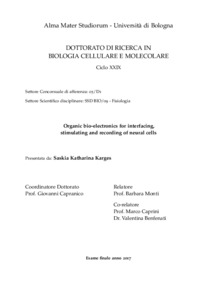Karges, Saskia Katharina
(2017)
Organic Bio-Electronics for Interfacing, Stimulating and Recording of Neural Cells, [Dissertation thesis], Alma Mater Studiorum Università di Bologna.
Dottorato di ricerca in
Biologia cellulare e molecolare, 29 Ciclo. DOI 10.6092/unibo/amsdottorato/8001.
Documenti full-text disponibili:
![[img]](http://amsdottorato.unibo.it/8001/1.hassmallThumbnailVersion/PhDThesis_Karges_UniBO.pdf)  Anteprima |
|
Documento PDF (English)
- Richiede un lettore di PDF come Xpdf o Adobe Acrobat Reader
Disponibile con Licenza: Salvo eventuali più ampie autorizzazioni dell'autore, la tesi può essere liberamente consultata e può essere effettuato il salvataggio e la stampa di una copia per fini strettamente personali di studio, di ricerca e di insegnamento, con espresso divieto di qualunque utilizzo direttamente o indirettamente commerciale. Ogni altro diritto sul materiale è riservato.
Download (12MB)
| Anteprima
|
Abstract
One of the main reasons for the difficulty of providing a treatment of a huge number of disorders of the brain is the lack of deeper insight on how it works. Even after centuries of research, there are no efficient tools at hand to create this deeper insight. Recently, an increasing attention is focused on organic bioelectronics, aimed at engineering, fabrication and characterization of improved biocompatible, conformable and low cost processing devices that enable stimulation and recording of neural cells to provide an unprecedented insight into the brain’s physiology and pathophysiology. These new devices are hot candidates in order to create efficient tools for research and diagnosis and to establish a working ’machine-to-brain’ communication. Still there is room for improvement in the used materials, for example in the biocompatibility. To this aim, a novel quaterthiophene (T4) semiconductor, covalently modified with lysine- ends (T4Lys), was fabricated and characterized. The material was then tested as interface for DRG primary neurons. By whole-cell patch-clamp, it was examined if the biofunctionality of neurons cultured on T4Lys was preserved and if this organic interface enabled functional differentiation of DRG primary neurons. Not only neurons but also astrocytes, their ion channels and calcium signaling play a crucial role in the physiology and pathophysiology of the central nervous system. In this context novel tools are needed to also monitor and/or modulate the astrocytic biochemical and bioelectrical activity. To this end, an organic field effect transistor device (O-CST), was interfaced with astroglial cells. In this context the biocompatibility of the organic material P13 and its preservation of the astrocytic electrophysiological properties in vitro was investigated, and the impact of a P13-based organic field effect transistor on the astrocytic ionic conductance studied. The evoked response to device stimulation was characterized and the necessity of device integrity investigated.
Abstract
One of the main reasons for the difficulty of providing a treatment of a huge number of disorders of the brain is the lack of deeper insight on how it works. Even after centuries of research, there are no efficient tools at hand to create this deeper insight. Recently, an increasing attention is focused on organic bioelectronics, aimed at engineering, fabrication and characterization of improved biocompatible, conformable and low cost processing devices that enable stimulation and recording of neural cells to provide an unprecedented insight into the brain’s physiology and pathophysiology. These new devices are hot candidates in order to create efficient tools for research and diagnosis and to establish a working ’machine-to-brain’ communication. Still there is room for improvement in the used materials, for example in the biocompatibility. To this aim, a novel quaterthiophene (T4) semiconductor, covalently modified with lysine- ends (T4Lys), was fabricated and characterized. The material was then tested as interface for DRG primary neurons. By whole-cell patch-clamp, it was examined if the biofunctionality of neurons cultured on T4Lys was preserved and if this organic interface enabled functional differentiation of DRG primary neurons. Not only neurons but also astrocytes, their ion channels and calcium signaling play a crucial role in the physiology and pathophysiology of the central nervous system. In this context novel tools are needed to also monitor and/or modulate the astrocytic biochemical and bioelectrical activity. To this end, an organic field effect transistor device (O-CST), was interfaced with astroglial cells. In this context the biocompatibility of the organic material P13 and its preservation of the astrocytic electrophysiological properties in vitro was investigated, and the impact of a P13-based organic field effect transistor on the astrocytic ionic conductance studied. The evoked response to device stimulation was characterized and the necessity of device integrity investigated.
Tipologia del documento
Tesi di dottorato
Autore
Karges, Saskia Katharina
Supervisore
Co-supervisore
Dottorato di ricerca
Ciclo
29
Coordinatore
Settore disciplinare
Settore concorsuale
Parole chiave
Astrocytes, TRPV4, TRPV1, Organic Bioelectronics, Organic Device, OFET, O-CST
URN:NBN
DOI
10.6092/unibo/amsdottorato/8001
Data di discussione
19 Aprile 2017
URI
Altri metadati
Tipologia del documento
Tesi di dottorato
Autore
Karges, Saskia Katharina
Supervisore
Co-supervisore
Dottorato di ricerca
Ciclo
29
Coordinatore
Settore disciplinare
Settore concorsuale
Parole chiave
Astrocytes, TRPV4, TRPV1, Organic Bioelectronics, Organic Device, OFET, O-CST
URN:NBN
DOI
10.6092/unibo/amsdottorato/8001
Data di discussione
19 Aprile 2017
URI
Statistica sui download
Gestione del documento:


 Login
Login
